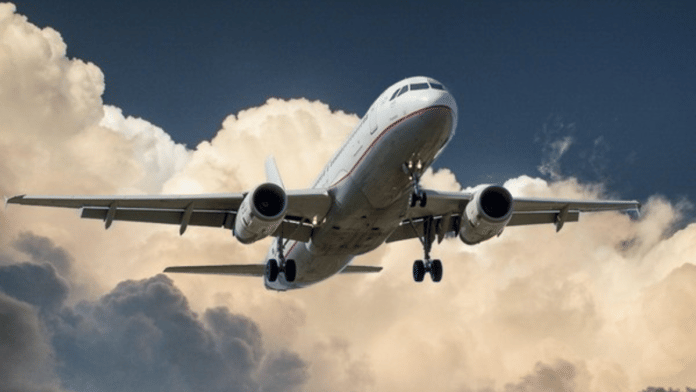New Delhi: The Indian aviation industry is expected to log a net loss of Rs 30-40 billion (3,000 to 4,000 crore) in the current financial year, similar to the loss posted in 2023-24, according to ratings agency ICRA. It’s anticipated that the industry will see a gradual pace of recovery in earnings, amid high costs as well as challenges related to supply chains and availability of crew and pilots.
“The pace of recovery in industry earnings is likely to be gradual owing to the high fixed-cost nature of the business… ICRA expects the Indian aviation industry to report a similar net loss of Rs 30-40 billion in FY2025 as seen in FY2024, which is significantly lower from levels of Rs. 170-175 billion in FY2023, as airlines continue to witness healthy passenger traffic growth and maintain pricing discipline,” the ratings agency said in a report.
It noted that the industry reported a net loss of Rs 170-175 billion (17,000-17,500 crore) in FY2023 due to elevated ATF (aviation turbine fuel) prices along with the depreciation of the rupee against the US dollar.
The agency further said that there were some near-term headwinds for the industry, including supply chain challenges, engine failure issues, and crew and pilot availability. “The airlines’ ability to raise yields proportionate to their input cost increases will be key to expand their profitability margins,” it added.
Separately, according to consultancy firm CAPA India, Indian airlines are expected to post a bigger industry-wide loss in fiscal 2025 as higher costs outweigh rising demand and costlier tickets. CAPA India estimated losses for the fiscal year ending
March 2025 at between $400 million (40 crore) and $600 million against a loss of $300 million-$400 million in the previous year.
India is currently among the world’s fastest-growing aviation markets with strong demand for domestic and international travel. According ICRA, domestic air passenger traffic in FY24 (April 2023–March 2024) grew 13 percent year-on-year to 15.4 crore, surpassing pre-Covid levels of 14.2 crore in FY20. Additionally, in the last financial year, the international passenger traffic for Indian carriers grew 24 percent to 296.8 lakh , higher than the peak levels of 259 lakh in FY2019.
For the first two months of the current fiscal (April-May 2024), domestic air passenger traffic was 270.9 lakh.
Elevated ATF prices, depreciation of rupee
ICRA said that despite a healthy recovery in air passenger traffic and improvement in yields, the movement of the latter will remain monitorable due to elevated ATF prices and depreciation of the rupee vis-à-vis the US dollar over pre-Covid levels, as both these factors have a major bearing on the airlines’ cost structure.
Fuel cost accounts for 30 to 40 percent of the airlines’ expenses, while 45 to 60 percent of the operating expenses, including aircraft lease payments, fuel expenses and a significant portion of aircraft and engine maintenance expenses, are denominated by the dollar.
While there has been some decline in ATF prices, they remain higher than pre-Covid levels. ICRA noted that average ATF prices stood at Rs 103,499/kilolitre (kl) in FY2024, which was lower by 14 percent than Rs. 121,013/kl in FY2023. However, these were significantly higher (by 58 percent) than the pre-Covid levels of Rs. 65,368/kl in FY2020. In Q1 FY2025, the average ATF price remained higher by 5.4 percent on a year-on-year basis.
Additionally, the industry has been facing supply chain challenges and aircraft and crew shortages. While in FY2024, GoFirst filed for bankruptcy citing faulty Pratt and Whitney (P&W) engines which stalled the airline’s operations, IndiGo had grounded more than 70 aircraft due to the P&W engine issues as of May 23, 2024.
“It is estimated that 24-26 percent of the total fleet of Indian airlines in operations was grounded by March 31, 2024. Considering the bulk recall of the engines globally by P&W and other existing issues with the OEM’s engines, the testing by P&W is likely to take longer, around 250-300 days,” ICRA said.
This will result in increased operating expenses towards the cost of grounding, increased lease rentals due to additional aircraft being taken on lease to offset the grounded capacity, rising lease rates and lower fuel efficiency (due to replacement with older aircraft taken on spot lease), which will adversely impact an airline’s cost structure.
“However, healthy yields, high passenger load factor (PLF) and partial compensation available from engine OEMs would help absorb the impact to an extent,” ICRA said, adding that in the current fiscal, the industry has also faced challenges related to availability of pilot and cabin crew, leading to several flight cancellations and delays, which impacted capacity availability and added to customer grievances.
The shortage of pilots and crew saw major flight disruptions for Vistara and Air India Express in recent months. In April, Vistara announced it would reduce its network capacity by 10 percent or 25-30 daily flights on a daily basis amid a paucity of pilots.
This was followed by severe disruption of operations due to crew unavailability, with several pilots taking sick leave to protest the new pay structure implemented by the airline. A few weeks later, a similar incident occurred at Air India Express, and the airline had to cancel several flights after about 300 members of its cabin crew called in sick at the last minute.
“ICRA’s outlook on the Indian aviation industry is stable, amid the continued recovery in domestic and international air passenger traffic, with a relatively stable cost environment and expectations of the trend continuing in FY2025,” the agency said.
ICRA added that the momentum in air passenger traffic witnessed in FY2024 was expected to continue into FY2025, though further expansion in yields from the current levels may be limited.
(Edited by Tikli Basu)
Also read: Redbird’s grounding not first sign of India’s flight training woes, but has made pilot shortage dire






